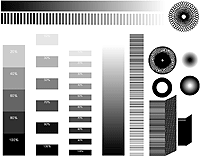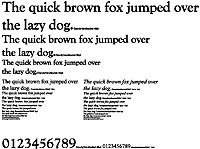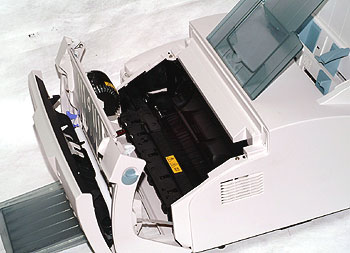The next set of tests revolve
around a set of laser printer test patterns we originally stumbled upon at ZDnet
a few years ago. The patterns come in several type including Adobe
Illustrator, Adobe Acrobat and Jpeg image formats. Ideally, the Illustrator
patterns should be used but if you don't have the software the PDF files offer a
good alternative. The JPEG test patterns should be avoided since none of the
images are stored as vectors and so the resolution is not very
good.
Of the two test patterns we
used, the first is for measuring gradients and resolution reproduction and
the second is for testing letter quality at different font
sizes.
| Gradient Test |
|
Font Test |
 |
|
 |
Since the Samsung SF-531P
handles both direct printing, and scanning & printing we are going to break
up the test results by those two categories.
Gradient Test Pattern: The test pattern
illustrates both a vertical and horizontal gradient bar which should
ideally move smoothly from black to white with no visible banding or
jarring. At 600dpi printing the horizontal gradient is very smooth no
visible signs of banding at all. The vertical gradient gradient bar also
shows pretty smooth transitions, but there were some faint streaks from the
printing mechanism itself and it was unable to display the 10% black shade at
all.
Scanning in the same
document to print a copy illustrated that the SF531P is really best
suited to plain text. The horizontal gradient bar was poorly transitioned,
and the shading heavily pixelated because the scanning resolution is just
300x300 dpi. The vertical gradient bar was equally unimpressive in this
scanning test. A 20% gradient was the lowest saturation
visible.
Line, and Angled Lines Test Pattern: The solid
horizontal lines at both 600 perfect and the angled lines (both sizes) are
also well displayed. The scanned and printed page faired very well with the
solid horizontal lines, and the large angled lines. The smaller angeled lines
were distorted, and blurred.
Bezier Curves and Radial Fills: The curves and
radial fills printed out very nicely, with even spirals and only scant
instances of blotching visible at 600dpi. The scanned and copied document did
well with the bezier curves, and very poorly with the radial fils - again
illustrating that the SF-531P handles solid lines better than
gradients.
Font Size Test Pattern:The type test pattern has one sentence, "The quick brown fox
jumped over the lazy dog" written in sizes ranging from 48-point to 4-point. In
each cases the text is clearly legible, even at the smallest size, but the
upward strokes disappear on some letters (like "v"). This is a pretty common
aspect of the Samsung printers we have tested. The scanned and copied document
handled the text well, but the smallest font was not easily readable, though it
was legible for the most part. Pixelization of the characters was visible at all
font sizes after scanning and coping the document since the scanner is limited
to 300x300dpi at the standard setting.
Final Conclusions:
 When we started testing out the Samsung
SF-531P we expected it to handle printing, faxing, copying and telephone
applications. After becoming more familiar with it we also discovered the
scan-to-email, and scan-to-OCR functions brought out through Samsung's software
package. Depending on your line of work OCR is either an absolute necessity, or
something which doesn't get that much use. Around here we don't have much need
for OCR capabilities, but it is nice to know that the feature is just a click
away.
When we started testing out the Samsung
SF-531P we expected it to handle printing, faxing, copying and telephone
applications. After becoming more familiar with it we also discovered the
scan-to-email, and scan-to-OCR functions brought out through Samsung's software
package. Depending on your line of work OCR is either an absolute necessity, or
something which doesn't get that much use. Around here we don't have much need
for OCR capabilities, but it is nice to know that the feature is just a click
away.
As a
laser printer the SF531P handles the
task well, but not quickly. The SF531P is limited to 600dpi resolutions and 8
pages per minute printing. The box comes with a starter toner cartridge which
should last around 2000 sheets which is a nice bonus, and in our tests the print
quality of the unit was very competitive. The paper tray holds about 50-100
sheets, and has adjustable guides for letters, and different sized paper up to
about 8.5" in width.
As a copier the SF531P gets
the job done but it is clear that this feature isn't
a substitute for a photocopier - the SF531P works well with text based documents,
but gradients, images, and other objects with shading are not copied very
well.
As a fax, the SF531P has more features than we can really list
here; a 20-number auto dial, handset, and handy set of advanced faxing tools
are the most significant but there are many more. As a fax the SF531P
shines, though with only 2MB of storage memory it may have been better to include
a larger paper tray that what is afforded for currently. Bottom line, if you run
you own SOHO business a multifax printer/fax/scanner is a must have - they
are simply so useful and provide such good value. The Samsung SF531P is a good
model in most respects, and in the core competencies works very well. It doesn't
provide top of the line specs in any one category, but when you
consider its retail price tag it does top the list in terms of value.
